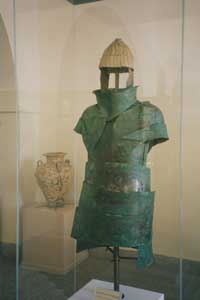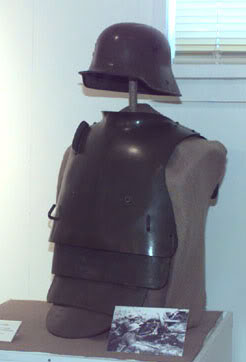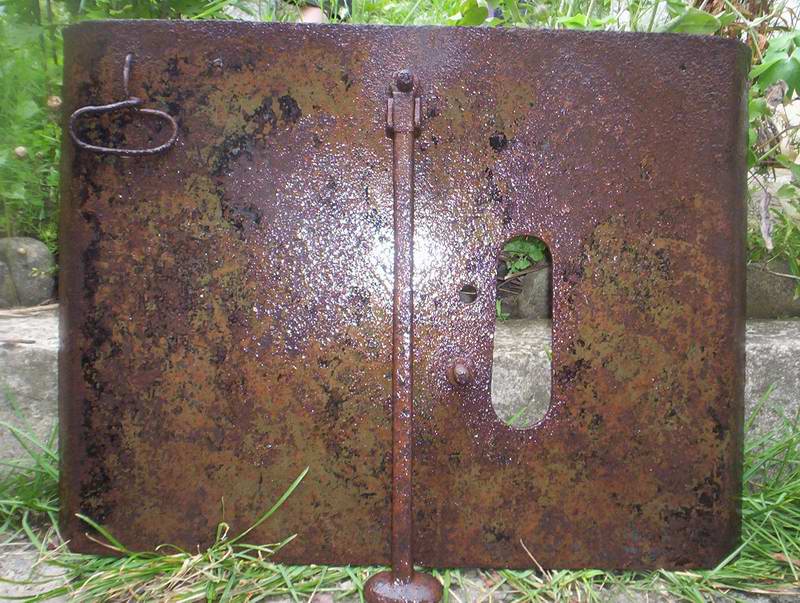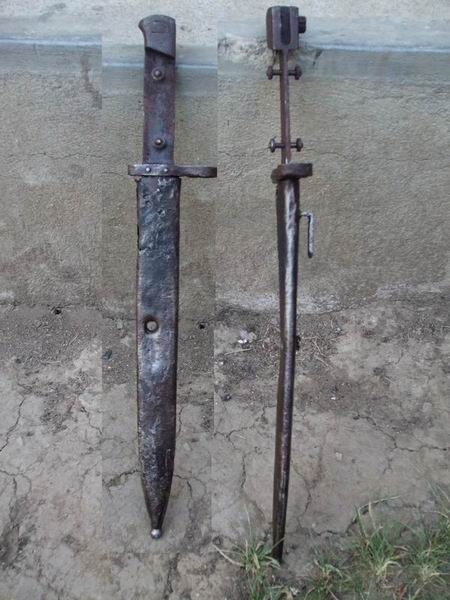| Author |
Message |
|
Connor Lynch
|
 Posted: Fri 06 Aug, 2010 1:20 pm Post subject: Ww1 german armour Posted: Fri 06 Aug, 2010 1:20 pm Post subject: Ww1 german armour |
 |
|
A little similar to Mycean armour im not sure if im spelling mycean right.

|
|
  |
 |
|
Philip Montgomery
|
 Posted: Fri 06 Aug, 2010 1:58 pm Post subject: Posted: Fri 06 Aug, 2010 1:58 pm Post subject: |
 |
|
Interesting armor. Many years ago, I read about and saw a picture of German armor from World War I. Connor, did you have a question about the armor? Do you know anything about it? What German units wore the armor? Do you know anything about the steel or the design?
Philip Montgomery
~-----~
"A broken sword blade fwipping through the air like a scythe through rye does demand attention."
|
|
  |
 |
|
Connor Lynch
|
 Posted: Fri 06 Aug, 2010 2:05 pm Post subject: Posted: Fri 06 Aug, 2010 2:05 pm Post subject: |
 |
|
|
I dont know much about it. I just wanted to post it , all i know is that it is from ww1used to stop bullets.
|
|
  |
 |
Scott Hrouda

|
 Posted: Fri 06 Aug, 2010 2:55 pm Post subject: Posted: Fri 06 Aug, 2010 2:55 pm Post subject: |
 |
|
It is fun to compare and contrast with this picture of mycenaean armor.
 Attachment: 4.8 KB Attachment: 4.8 KB

...and that, my liege, is how we know the Earth to be banana shaped. - Sir Bedevere
|
|
  |
 |
|
Connor Lynch
|
 Posted: Fri 06 Aug, 2010 4:40 pm Post subject: Posted: Fri 06 Aug, 2010 4:40 pm Post subject: |
 |
|
|
Yes the helmets are different though, that helmet is made out of boar tusks i have read. Other than that the armour is very similar. I wonder how the Germans thought of that kind of armour without looking at actual Mycenean armour. The only thing is that the color of the armour doesnt match the color of the helmet.
|
|
  |
 |
|
Jonathan Hopkins
|
 Posted: Fri 06 Aug, 2010 5:03 pm Post subject: Posted: Fri 06 Aug, 2010 5:03 pm Post subject: |
 |
|
It is somewhat similar, but if you look at the German armor from a different angle you will see that it does not enclose the body like the Mycenaean armor.
Image from Illinois National Guard WWI Exhibit

|
|
  |
 |
|
David Sutton
|
 Posted: Sat 07 Aug, 2010 4:19 am Post subject: Posted: Sat 07 Aug, 2010 4:19 am Post subject: |
 |
|
The armour also resembles some forms of 14th Century coats of plates, like this one excavated from Visby:


'Reserve your right to think, for even to think wrongly is better than not to think at all'
'To teach superstitions as truth is a most terrible thing'
Hypatia of Alexandria, c400AD
|
|
  |
 |
|
JG Elmslie
Industry Professional
|
 Posted: Sat 07 Aug, 2010 5:24 am Post subject: Posted: Sat 07 Aug, 2010 5:24 am Post subject: |
 |
|
the designer/artist/craftsperson in me combined with the bitter, jaded cynic at this point, and I cant help but say:
Is'nt it strange... humans are all the same shape, and we end up with design solutions that are fundamentally similar for the same target goals....
weird, that, is'nt it?
|
|
   |
 |
|
Lin Robinson
|
 Posted: Sat 07 Aug, 2010 10:03 am Post subject: Posted: Sat 07 Aug, 2010 10:03 am Post subject: |
 |
|
Truly there is little new under the sun. All sorts of things have been copied over generations.
A little background on the German armor. Production figures indicate about 500,000 sets were made, mostly in the middle of the war when trench warfare began in earnest. The armor was issued to snipers - a steel brow plate to fit on the 1916 helmet was also issued during that time - and shock troops who were tasked with raiding enemy trenches. It proved to be too heavy and bulky for the type of movements required by trench raids and seems to have been discarded fairly quickly. The brow plate on the helmet hung around a bit longer, although its added weight tended to cause the helmet to tilt forward and obscure the soldier's vision. It is hard to see how this thing would have helped the sniper, whose survival depended in large measure on stealth, which this piece of equipment probably hampered more than it helped. The body armor would just extra weight for a sniper. A skilled sniper will never expose much of anything to the enemy he is trying to shoot.
Lin Robinson
"The best thing in life is to crush your enemies, see them driven before you and hear the lamentation of their women." Conan the Barbarian, 1982
|
|
  |
 |
|
Alan H. Weller
Location: Palo Alto, CA Joined: 31 Oct 2006
Posts: 28
|
 Posted: Sat 07 Aug, 2010 12:15 pm Post subject: Posted: Sat 07 Aug, 2010 12:15 pm Post subject: |
 |
|
Connor Lynch wrote:
"I wonder how the Germans thought of that kind of armour without looking at actual Mycenean armour"
The most famous early archaelogist of Mycenaean sites was the German, Heinrich Schliemann.
Heinrich Schliemann (German pronunciation: [ˈʃliːman]; (January 6, 1822, Neubukow, Mecklenburg-Schwerin December 26, 1890, Naples) was a German businessman and archaeologist, and an advocate of the historical reality of places mentioned in the works of Homer. Schliemann was an important archaeological excavator of Troy, along with the Mycenaean sites Mycenae and Tiryns. His successes lent material weight to the idea that Homer's Iliad and Virgil's Aeneid reflect actual historical events.
|
|
  |
 |
Romulus Stoica

Location: Hunedoara, Transylvania, Romania Joined: 26 Oct 2006
Posts: 124
|
 Posted: Sat 07 Aug, 2010 12:57 pm Post subject: Posted: Sat 07 Aug, 2010 12:57 pm Post subject: |
 |
|
|
In W.W.1 and in the '20, there were a lot of discussions and experiments about/with different form of body armor. Many armies used body armor in W.W.1 but with little succes, I know about, english, US, german, french, belgian and russian armies. There were a lot of stange designs like visored helmets and coat-of-plates-like armor. I know there is a W.W.1 body armor book in pdf format, free to download somewhere on the Internet for those interested
|
|
   |
 |
|
Connor Lynch
|
 Posted: Sat 07 Aug, 2010 1:54 pm Post subject: Posted: Sat 07 Aug, 2010 1:54 pm Post subject: |
 |
|
|
Oops my mistake i didnt know. Knowing that they have had to have based their armour on ancient myceaen
|
|
  |
 |
|
Jonathan Hopkins
|
 Posted: Sat 07 Aug, 2010 3:48 pm Post subject: Posted: Sat 07 Aug, 2010 3:48 pm Post subject: |
 |
|
|
IMO the resemblance is superficial. Other than looking vaguely similar and being displayed in a similar manner, I think the construction is very different.
|
|
  |
 |
Thom R.

|
|
  |
 |
|
Jonathan Hopkins
|
 Posted: Sat 07 Aug, 2010 7:05 pm Post subject: Posted: Sat 07 Aug, 2010 7:05 pm Post subject: |
 |
|
Thom,
Thanks for the great links, and the Dean link in particular!
Jonathan
|
|
  |
 |
|
Ozsváth Árpád-István
|
 Posted: Sat 07 Aug, 2010 8:26 pm Post subject: Posted: Sat 07 Aug, 2010 8:26 pm Post subject: |
 |
|
500,000 seems a bit exagerated for something weird and experimental like this. At least I never found a single piece. Maybe they soon realized that this won't protect soldiers from enemy fire.
 Attachment: 114.09 KB Attachment: 114.09 KB

They used armor plates like this. The 5-6 mm thick armor wasn't enough to stop a rifle bullet. I saw quite a few plates with bulletholes. Sometimes they used double sets of these.
 Attachment: 54.07 KB Attachment: 54.07 KB

No comment...
 Attachment: 123.6 KB Attachment: 123.6 KB
Some believed that an entrenching tool will stop bullets. They were wrong. [ Download ]
|
|
   |
 |
|
|

